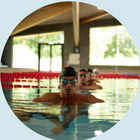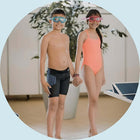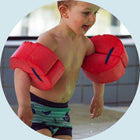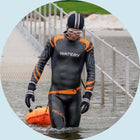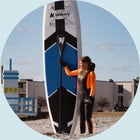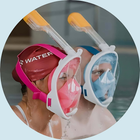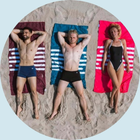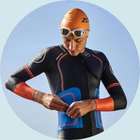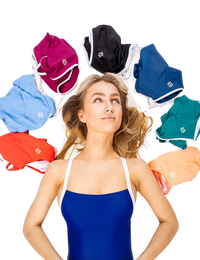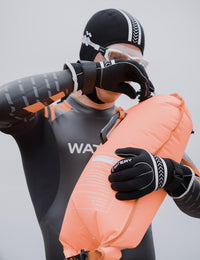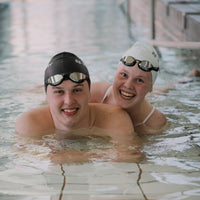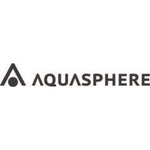In short: Behind this guide is me - Daniel, owner of Watery.dk and a former elite swimmer for 10 years, now a recreational triathlete. With my extensive experience in open water swimming, including numerous open water and triathlon events, I've accumulated significant knowledge about wetsuits. I'm here to share my insights to assist you in your journey.
Here's what I'll cover:
(Click on the text to jump directly to the section)
-
Why Use a Wetsuit for Open Water and Triathlons?
- How to Choose the Right Wetsuit
- Buying a Wetsuit - Our Best Recommendations
- Wetsuit Rules for Competitions
- How to Easily Put On and Take Off a Wetsuit
-
Using Body Cream or Friction Gel - and What to Avoid
- How to Properly Maintain and Store Your Wetsuit
Why Use a Wetsuit for Open Water and Triathlons?
Let's start by stating the obvious. In Denmark, regardless of the time of year, the water temperature is almost always low enough that wearing a wetsuit is essential - whether it's for daily open water swim training or during the actual competition.
Besides protecting your body from the cold water by keeping you warm and preventing cold water from getting too close to your body, a wetsuit offers several other advantages:
- Increases your buoyancy, which is especially beneficial for less experienced swimmers
- Protects you from water- and jellyfish
- Reduces water resistance due to their special smooth surface
- Gives you the necessary freedom of movement
- Keeps your muscles warm, preventing hypothermia during and after swimming
- Extends the open water swimming season
So besides its warming function, a wetsuit for swimming actually helps improve your speed in the water.
Fun Fact: The right wetsuit can reduce swim times by up to 2 minutes per 1000 meters.

How to Choose the Right Wetsuit
When buying a new wetsuit, there are essential considerations to ensure you get the perfect one for your needs. Think about: the size, thickness, and fit. Learn more about each in the sections below.
1. How to Choose the Size of Your Wetsuit
Choosing the right wetsuit size is often the big question, and many make mistakes here.
To complicate matters, sizes don't just come in small, medium, and large. You can also find sizes like small tall, medium tall, medium-large, etc. Therefore, it's important to pay close attention when reading size guides and measuring yourself.
Most wetsuit brands provide a size guide. They offer useful hints about which size you need. These guides often use your height and weight as parameters for the correct size.
If you're between multiple sizes, the general rule of thumb is weight before height because a few centimeters in length won't make much difference. Therefore, if you fit into multiple sizes, focus on weight over height.
Size guides for different wetsuits:
- Size guide for Tyr Hurricane wetsuits
- Size guide for Speedo wetsuits
- Size guide for Aqua Sphere wetsuits - For men here and for women here
- Size guide for popular Pelican wetsuits for men and women (see below)
Pelican wetsuit size chart for men:
| Size | Weight | Height | Chest | Waist | Hips | Ankles | Thighs |
|---|---|---|---|---|---|---|---|
| Small | 60-70 kg | 150-165 cm | 88 cm | 64 cm | 84 cm | 18.3 cm | 46 cm |
| Small/Medium | 64-75 kg | 160-170 cm | 88 cm | 64 cm | 84 cm | 18.3 cm | 46 cm |
| Medium | 72-85 kg | 172-184 cm | 92 cm | 68 cm | 88 cm | 19 cm | 48 cm |
| Medium/Large | 80-90 kg | 182-190 cm | 92 cm | 68 cm | 88 cm | 19 cm | 48 cm |
| Large | 87-100 kg | 184-194 cm | 96 cm | 72 cm | 92 cm | 19.7 cm | 50 cm |
| X-Large | 95-104 kg | 190-198 cm | 100 cm | 76 cm | 96 cm | 20.4 cm | 52 cm |
| XX-Large | 99-108 kg | 195-204 cm | 104 cm | 80 cm | 100 cm | 21.1 cm | 54 cm |
Pelican wetsuit size chart for women:
| Size | Weight | Height | Chest | Waist | Hips | Ankles | Thighs |
|---|---|---|---|---|---|---|---|
| X-Small | 45-51 kg | 139-155 cm | 76 cm | 58 cm | 86 cm | 18.6 cm | 48 cm |
| Small | 49-55 kg | 147-160 cm | 80 cm | 62 cm | 90 cm | 19.3 cm | 50 cm |
| Medium | 56-64 kg | 160-175 cm | 84 cm | 66 cm | 94 cm | 20 cm | 52 cm |
| Medium-Large | 63-70 kg | 167-180 cm | 86 cm | 66 cm | 94 cm | 20 cm | 52 cm |
| Large | 66-75 kg | 169-182 cm | 88 cm | 70 cm | 98 cm | 20.7 cm | 54 cm |
| X-Large | 75-86 kg | 172-184 cm | 92 cm | 74 cm | 102 cm | 21.4 cm | 56 cm |
| XX-Large | >86 kg | >184 cm | 96 cm | 78 cm | 106 cm | 22.1 cm | 58 cm |
- Size guide for Zoggs wetsuits:
When assessing whether your wetsuit fits properly, the most important area should be around the neck, ensuring a snug fit. If you can't slide a finger between your neck and the wetsuit, it's just right. Otherwise, cold water will seep in, negating the insulating effect.
Also note, if the wetsuit feels tight and snug on land, it will likely fit perfectly once you're in the water. When you're submerged, the suit adjusts and feels more natural.
2. What Thickness Should a Wetsuit Be and Which Should You Choose?
There are various thicknesses available in wetsuits, and it's crucial to pick the right one according to your swimming style and desired warmth level.
Generally, there are three different thicknesses. When to use which is detailed below:
-
3mm: This thickness is by far the most common for triathlons and open water swimming due to its exceptional flexibility and the ability to stay in the water for longer periods.
-
5mm: Primarily used for open water training/events during spring or late fall when the water isn't as warm, providing both warmth and considerable flexibility. Also offers increased buoyancy.
- 7mm: Ideal for those who dislike the cold, although it’s not perfect for open water swimming due to reduced mobility and excessive buoyancy. Often used for diving rather than swimming.
Additionally, note that some wetsuits are inherently 5mm around the legs, chest, and stomach/hip areas to enhance buoyancy and minimize drag, whereas the shoulder area is thinner to boost flexibility. This arrangement is the most optimal, offering high buoyancy in crucial areas and full arm mobility.
NOTE: For competitive open water or triathlon events, the wetsuit must not exceed 5mm in thickness. Exceed and you won't be allowed to swim.
| Thickness | When to Use | Advantages | Disadvantages/Limitations |
|---|---|---|---|
| 3 mm | The most common choice for triathlons and open water. Ideal from spring to late summer. | High mobility and comfort. Good balance between warmth and flexibility. | Not optimal for very cold waters. |
| 5 mm | Used during cooler periods (early spring/late fall). Good for training and competitions. | Provides extra warmth and buoyancy. Still relatively flexible. | Less flexible than 3mm. |
| 7 mm | Suitable for very cold waters or those prone to being cold. Often used for diving. | Very warm. Maximum buoyancy. | Too rigid for regular swimming. Not allowed in competitions. |
3. Type of Wetsuit - Should You Choose Full or Half Wetsuit?
A question many have, but there's a reasonably clear answer:
If you plan to swim in open water here in Denmark or compete in a Danish triathlon or open water event, 99% of the time you should opt for a full wetsuit with both sleeves and extending to your feet. A full wetsuit provides essential warmth and buoyancy, which a half wetsuit cannot match.
The exception to choosing a half wetsuit, offering more shoulder mobility, is if you're participating in a triathlon in a warm country abroad.
Otherwise, always choose a full wetsuit.
Wetsuits for Beginners - Here's What to Look For
It might be tempting to purchase the most expensive wetsuit on the market, thinking it's your best bet. However, that's not necessarily the case, especially if you're new to triathlons or open water swimming.
As a beginner, you'll likely benefit more from a wetsuit that enhances buoyancy, and beginner suits often excel in this area. They tend to be thicker around the legs and hips, which elevates those areas that might otherwise "sink" slightly, hence reducing water resistance.
However, the material in these suits may not be as flexible as top-tier models, potentially feeling stiffer around the shoulders. But this isn't significant if your primary goal is to navigate your first swim or competition comfortably.
So: If you're aiming to complete and enjoy the experience, opt for a beginner suit priced between 1,500 to 2,500 kr. That's sufficient, allowing you to invest in quality swim goggles or better running shoes instead.
On the other hand, if you're an experienced swimmer with multiple competitions under your belt, it makes sense to consider slightly pricier, more technical models.
Check out our recommended wetsuits below 👇
GET A DISCOUNT CODE WITH 10% OFF
The discount code can be used by all new customers on all products on the website, including the products recommended here in the article.
What are you waiting for? Get more out of your time in and on the water!
Buy a Wetsuit - Our Recommendations for Beginners, Intermediate, and Professionals
If you want a wetsuit with optimal shoulder flexibility, high buoyancy, and lasting durability, be prepared for the cost. Considering the budget constraints many open water swimmers and triathletes face, below are my top six wetsuit recommendations based on experience for the new beginner, the intermediate, and the professional:
Wetsuit for Beginners:
These wetsuits fall under the category of budget triathlon and open water wetsuits, adhering to the thickness rule while delivering the four crucial features of keeping muscles warm, enhancing buoyancy, reducing water resistance, and surprisingly allowing a good degree of freedom (though not as expansive as pricier top models).
These are tailored for newly initiated open water swimmers still gauging their inclination towards it. Is that you? Give one of these a try:
Reptile Breast Wetsuit (Available for Men and Women)

Watery wetsuit for men - Reptile Breast - Orange
4.48/5
Based on 27 reviews

Watery wetsuit for women - Reptile Breast - Yellow
3.77/5
Based on 13 reviews
| Advantages | Disadvantages |
| Perfectly suited for breaststroke & freestyle | Less suitable for other swimming styles |
| Made with flexible Jako-neoprene | Limited color options |
| Ideal for beginners | |
| High visibility in the water |
The Watery Reptile Breast is the perfect wetsuit for beginners swimming breaststroke in open water – but it also works for freestyle. It’s a unique wetsuit specifically designed for breaststroke in open water – but works well for freestyle too. The neoprene thickness distribution (5 mm on the chest, 2 mm on the legs) allows for maintaining a natural breaststroke position.
Made with flexible Jako-neoprene and featuring internal Flex-compound panels, it offers optimal mobility for wide breaststroke kicks. The suit comes with either orange or yellow details to boost your visibility in the water.
Overall, it’s an ideal beginner suit suitable for both breaststroke and freestyle – perfect for those seeking high comfort, good buoyancy, and a natural swimming position.
Reptile Core Wetsuit (Available for Men and Women)

Watery wetsuit for men - Reptile Core - Black/orange
4.25/5
Based on 16 reviews

Watery wetsuit for women - Reptile Core - Black/purple
5.0/5
Based on 4 reviews
| Advantages | Disadvantages |
| Extremely popular among beginners | 2.5mm neoprene might feel colder |
| 2-2.5 mm neoprene for superior flexibility | |
| Economical price range |
The Watery Reptile Core is our most popular beginner suit – designed for both freestyle and breaststroke in open water. With ultra-flexible Yamamoto-neoprene (2–2.5 mm), it offers great buoyancy and high flexibility – particularly in the arms, where many newer swimmers can quickly fatigue.
The smooth-skin surface keeps water out, speed-cuff panels make it easy to remove, and orange details on the arms and legs ensure you’re visible in the water. It's all something I recommend!
Overall, this is the perfect wetsuit for those new to open water, allowing you to start strong without compromising on quality.
Wetsuit for Intermediate Swimmers:
These wetsuits employ a different type of neoprene that is both more flexible and smoother than used in beginner wetsuits.
If you're committed to triathlon or open water swimming, and have one or two races under your belt, consider upgrading to this category. These slightly pricier wetsuits provide improved flexibility, more color options, and additional panels to reduce drag.
Pelican Wetsuit (Available for Men and Women)

Watery wetsuit for women - Pelican - Purple
4.6/5
Based on 57 reviews

Watery wetsuit for men - Pelican - Orange
4.6/5
Based on 57 reviews
| Advantages | Disadvantages |
| Our most popular wetsuit ever | Best suited for water temperatures between 10 and 26 degrees |
| Varying thicknesses for optimal buoyancy | |
| Quick drying time |
Watery Pelican is a popular choice among intermediate swimmers seeking a wetsuit that delivers high comfort and solid performance in open water.
Featuring flexible Jako-neoprene in varying thicknesses, it provides excellent buoyancy around the hips and legs and impressive shoulder flexibility – ideal for both freestyle and breaststroke.
The wetsuit is smooth-skin treated for low water resistance and rapid drying, with speed-cuff panels for easy removal post-swim.
The combination of high visibility in water and strong durability makes Pelican a reliable choice for those with some experience wanting to elevate their swimming.
Wetsuit for Professionals:
Here you find the crème de la crème of wetsuits, where crafting them for speed, water repellency, and buoyancy borders on pure science. They utilize the finest neoprene types, offering peak elasticity and comfort.
These wetsuits, designed for professionals, seasoned athletes, or highly ambitious triathletes and open water swimmers, aim to make swimming faster through unique panels and more. If you won't compromise on anything, one of these is what you need.
Calder Rapid Wetsuit (Available for Men and Women)

Watery wetsuit for women - Calder Rapid - Black/pink
4.56/5
Based on 9 reviews

Watery wetsuit for men - Calder Rapid - Black/Blue
4.7/5
Based on 10 reviews
| Advantages | Disadvantages |
| Quick to put on and take off with key features | Less buoyancy in the legs and chest (designed for extra flexibility) |
| Constructed from the world's best neoprene (Yamamoto #39) | |
| Often on sale |
Calder Rapid is the ultimate wetsuit for those with extensive swimming experience – prioritizing flexibility, speed, and comfort as essentials rather than luxuries.
The suit is crafted in premium Yamamoto #39 neoprene, optimized for proficient swimmers with strong technique. The neoprene thicknesses are finely tuned to offer less buoyance in the arms and more freedom in the stroke – a feature only available in the best wetsuits. This results in a more natural water position and reduced fatigue over long distances.
The wetsuit also includes a breakaway YKK zipper for quick transitions, taped seams for maximum durability, and an SCS smooth-skin surface that minimizes water entry.
All in all, this is a wetsuit for those who already know what they want – and will not compromise on performance.
Recommended Extra Gear for Your Swim:
In conjunction with your wetsuit, several products can enhance your long and chilly open water swims. These include:
Sea Bag

Watery sea bag - Swim Buoy & Dry Bag 28L - Orange
4.85/5
Based on 54 reviews
A sea bag is essential safety gear for open water swimmers, combining practicality. Wearing it around your waist over your wetsuit, it "follows you" when inflated, heightening your visibility to watercraft, people on shore, and others in the water. Additionally, the small interior compartment allows you to stash valuables such as wallets, car keys, and phones, enabling emergency calls from the ocean.
We often recommend a 30-liter size for optimal buoyancy and storage. Watery sea bags are available in three distinct colors, ensuring you're visible in the water.
Check out our most popular sea bag without a window here.
Our most popular sea bag with a window can be viewed here.
Triathlon Swimming Goggles

Watery swim mask for adults - Mantis - White/grey
4.82/5
Based on 34 reviews
Open water triathlon swimming goggles differ from regular goggles. When swimming outdoors when the sun often shines bright (at least in summer), opt for lenses that are smoke, mirror, or polarized to avoid glare. Most open water swimmers prefer larger goggles with large frames for enhanced safety.
We typically recommend the Watery Mantis for open water swimmers here.
Visible Swim Cap

Watery swim cap (from 12 years) - Signature - Fluo green
4.64/5
Based on 141 reviews
Much like the sea bag, a visible swim cap increases your visibility in the water, potentially the difference between life and death. Therefore, always choose bright colors like Orange, Pink, Yellow, etc. Avoid blues, grays, or blacks.
To ensure water visibility, we've developed distinctive Watery swim caps to match our sea bags.
See our selection of swim caps here.
Changing Mat

Watery wetsuit changing mat - Oxford - Black
4.75/5
Based on 16 reviews
Anyone who's worn a wetsuit knows the struggle of changing without dirtying the suit and feet.
Thus, we've developed our immensely popular changing mat to simplify getting out of your dirty and wet wetsuit and/or clothes and into your car after a long day in the water – keeping feet clean and ready for socks.
The mat easily "ties" into a small carrying bag for the wetsuit.
Hood, Gloves, and Socks

Watery neoprene set - Thermal Reptile (3 mm) - Black/Silver
4.36/5
Based on 42 reviews
If you wish to start the season early/late, or are particularly sensitive to cold, neoprene socks, gloves, and a hood could be the solution. Both boots and a hood reduce cooling of feet and head. Consider neoprene gloves, though at the expense of reduced water feel, but it's an individual choice. These products enhance open water swimming, keeping in mind they're not allowed during open water and triathlon events, used only during training sessions.
We nearly always suggest at least 3 mm thickness for optimal warmth retention without sacrificing flexibility.
We recommend this Watery Thermal neoprene set here.
Friction Cream and Gel

Watery Friction Cream against chafing - Swimmers
4.88/5
Based on 8 reviews
Many open water swimmers experience friction sores or abrasions, especially around the neck and shoulders. Fortunately, newer suits leave significantly fewer abrasions, yet I still recommend friction cream for most.
Browse our range of friction creams here.
If you're currently suffering from abrasions, we suggest using Bodyglide here.
Wetsuit Rules for Competitions
The Danish Triathlon Federation has established basic rules for using wetsuits in triathlon events and open water races. It also dictates when/water temperatures that require wetsuits, thickness limits, and more.
Access the Danish Triathlon Federation's wetsuit rules here. For all age-group swimmers (everyone except elite), the basic regulations include:
- If water temperatures fall below 14 degrees, though rare in Danish summer triathlons, the distance can be shortened to minimize water time
- Wetsuits are compulsory for water temperatures between 14 and 22 degrees
- Wetsuits are forbidden for water temperatures above 22 degrees (almost never happens)
If you’re venturing into an open water or triathlon event, a wetsuit will be mandatory.
Additionally, note that official national and international event wetsuit requirements stipulate a maximum thickness of 5mm. Exceed that, and you're barred from competing.
Types of Wetsuits - What's the Difference Between a Swimsuit, Dry Suit, Neoprene, or Wetsuit?
There are countless names for wetsuits, attributed to diverse wetsuit types depending on whether they are designed for triathlon, open water, kitesurfing, diving, or other water sports. Below are definitions of the different types:
Dry Suit:
A dry suit is not particularly suited for various water sports like triathlon and open water because it doesn't fit snugly around the body as needed for such sports. So, do not opt for a dry suit if you plan on engaging in water activities.
Swimming Wetsuit for Triathlon and Open Water:
A swimming wetsuit is synonymous with a wetsuit, designed for triathlon or open water events. It’s what we recommend, and what this entire guide revolves around.
Its characteristic features include:
- Made from Neoprene
- Relatively thin (between 1 and 7mm)
- Good and natural for movement (swimming)
- Back zipper
Thus, a swimming wetsuit is exactly what you need.
How to Best Put On and Take Off Your Wetsuit
Putting on a wetsuit isn't just a walk in the park. Made from neoprene makes it incredibly difficult to put on, requiring practice to master the task quickly and efficiently.
A key reminder is to take your time and never rush through the process. Otherwise, you risk tearing your new suit.
At the core, the trick is running out of the water, putting your swim goggles on your forehead, pulling the wetsuit down from your upper body while running, taking off your swim cap and goggles just before entering the transition zone, and then removing the remainder of the wetsuit in front of your transition stand.
Using Body Cream / Bodyglide for Less Friction During Swimming with Wetsuit
Recently, a bad and somewhat inexplicable trend emerged where people used Vaseline around the neck and ankles to minimize friction from the wetsuit during long swims. Let's set the record straight: it doesn't really help since Vaseline washes away in the water and gradually damages the wetsuit.
Instead, use something designed to reduce friction when wearing wetsuits. Namely, Bodyglide, a highly popular product crafted to make swimming with a wetsuit much more pleasant. With Bodyglide, you can rest assured it won't wash away in the water or accelerate your expensive wetsuit's wear and tear.

Maintenance of Your Wetsuit
Taking proper care of your wetsuit before, during, and after use significantly extends its lifespan. Six basic tips for better wetsuit maintenance:
- Rinse the suit thoroughly inside and out immediately after use with fresh water from the ocean/lake. Most Ironman and Challenge events occur in saltwater, so be mindful.
- Hang the suit to dry inside out
- When dry and storing for the next training/event, ensure it's turned right side out, not crumpled, and hangs on a hanger or the like
- Avoid sharp nails while putting the suit on, as they can undesirably puncture the material
- Take time donning the suit. A thin thickness easily "leads to" a puncture or two - trust me on that ;-)
- If a tear occurs, repair it with neoprene glue
By following these six tips whenever your wetsuit is used, you're assured a usable wetsuit for two, three, four, or five years down the road.
Conclusion
We've reached the end of this comprehensive wetsuit guide. I hope you feel more knowledgeable and equipped to choose your first/next wetsuit. If you still have questions, don’t hesitate to reach out – and I'll help you as best as I can.
How many mm should a wetsuit be?
We recommend that wetsuits used for triathlon should be between 3 to 5 mm. You must not use wetsuits thicker than 5mm for races.
Which wetsuit for triathlon?
For triathlon in Denmark, you should choose a long-sleeved wetsuit as it is best suited for the cold water. Additionally, we recommend selecting a wetsuit with either a 3mm or 5mm thickness, and not thicker, as this is prohibited in official races.
Former elite swimmer and founder of Watery.dk
With over 10 years of competitive swimming experience and participation in multiple triathlons and open water events, Daniel founded Watery.dk to blend his passion for swimming with gear expertise and guidance.
